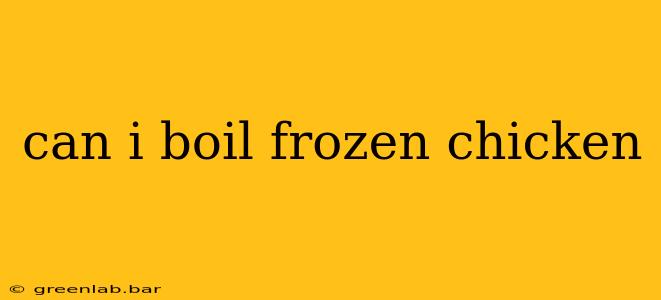Yes, you can boil frozen chicken, but it's crucial to understand the implications and follow proper safety guidelines to ensure a delicious and safe meal. Boiling frozen chicken requires longer cooking times compared to boiling fresh or thawed chicken, and careful attention to food safety is paramount. This guide will walk you through the process, addressing common concerns and providing tips for optimal results.
Why Boiling Frozen Chicken Might Be a Good Idea
Boiling frozen chicken can be a convenient option in several scenarios:
- Time-saving: It eliminates the need for thawing, saving you valuable time, especially if you're short on time for meal prep.
- Ease of use: It's a straightforward method, perfect for beginners or busy individuals.
- Versatile: The resulting cooked chicken can be used in various dishes, such as soups, stews, salads, or shredded for tacos or sandwiches.
How to Safely Boil Frozen Chicken
Important Note: While boiling frozen chicken is possible, it's generally recommended to thaw it first for optimal cooking results and even cooking. However, if you're pressed for time, here's how to do it safely:
-
Use Ample Water: Start with a large pot filled with plenty of cold water. Ensure the water completely submerges the frozen chicken. This ensures even cooking and prevents burning.
-
Bring to a Rolling Boil: Place the pot over high heat and bring the water to a rolling boil. This initial high heat helps break down the frozen exterior more quickly.
-
Reduce Heat and Simmer: Once boiling, immediately reduce the heat to a gentle simmer. This prevents the chicken from becoming tough and ensures the inside cooks thoroughly.
-
Check for Doneness: Cooking time will vary depending on the size and thickness of the chicken pieces. A good rule of thumb is to allow at least 1.5 to 2 times the usual cooking time for thawed chicken. Use a meat thermometer to ensure the internal temperature reaches 165°F (74°C) in the thickest part of the chicken. This is the only reliable way to guarantee it's cooked through and safe to eat. Do not rely solely on visual cues.
-
Cool and Store: Once cooked, remove the chicken from the pot and let it cool completely before storing it in an airtight container in the refrigerator. Cooked chicken should be refrigerated within two hours.
Potential Challenges and Solutions
- Uneven Cooking: Frozen chicken may cook unevenly. To mitigate this, use smaller pieces of chicken, ensure complete submersion in water, and monitor the cooking process closely.
- Tough Chicken: Overcooking can make the chicken tough. Use a meat thermometer to avoid overcooking. Simmering at a low temperature is crucial for tender chicken.
- Flavor Loss: Boiling can sometimes lead to a less flavorful outcome. Adding aromatics like onions, garlic, herbs, and spices to the boiling water can enhance the flavor of the cooked chicken.
Safety Precautions: Always Prioritize Food Safety
- Proper Thawing (Recommended): While boiling frozen chicken is possible, thawing it safely in the refrigerator is always the preferred method. This ensures more even cooking and reduces the risk of bacterial growth.
- Thorough Cooking: Always use a food thermometer to ensure the chicken reaches a safe internal temperature of 165°F (74°C). Undercooked chicken can cause foodborne illnesses.
- Hygiene: Maintain excellent hygiene throughout the cooking process. Wash your hands thoroughly before and after handling raw chicken.
Conclusion: A Convenient but Considerate Choice
Boiling frozen chicken offers convenience, but it requires careful attention to cooking time, temperature, and food safety. By following these guidelines and prioritizing safety, you can enjoy a delicious and safe meal. Remember that using a meat thermometer is the most critical step in ensuring food safety and achieving optimal cooking results. While convenient, thawing your chicken before boiling is the safer and often more palatable option.

